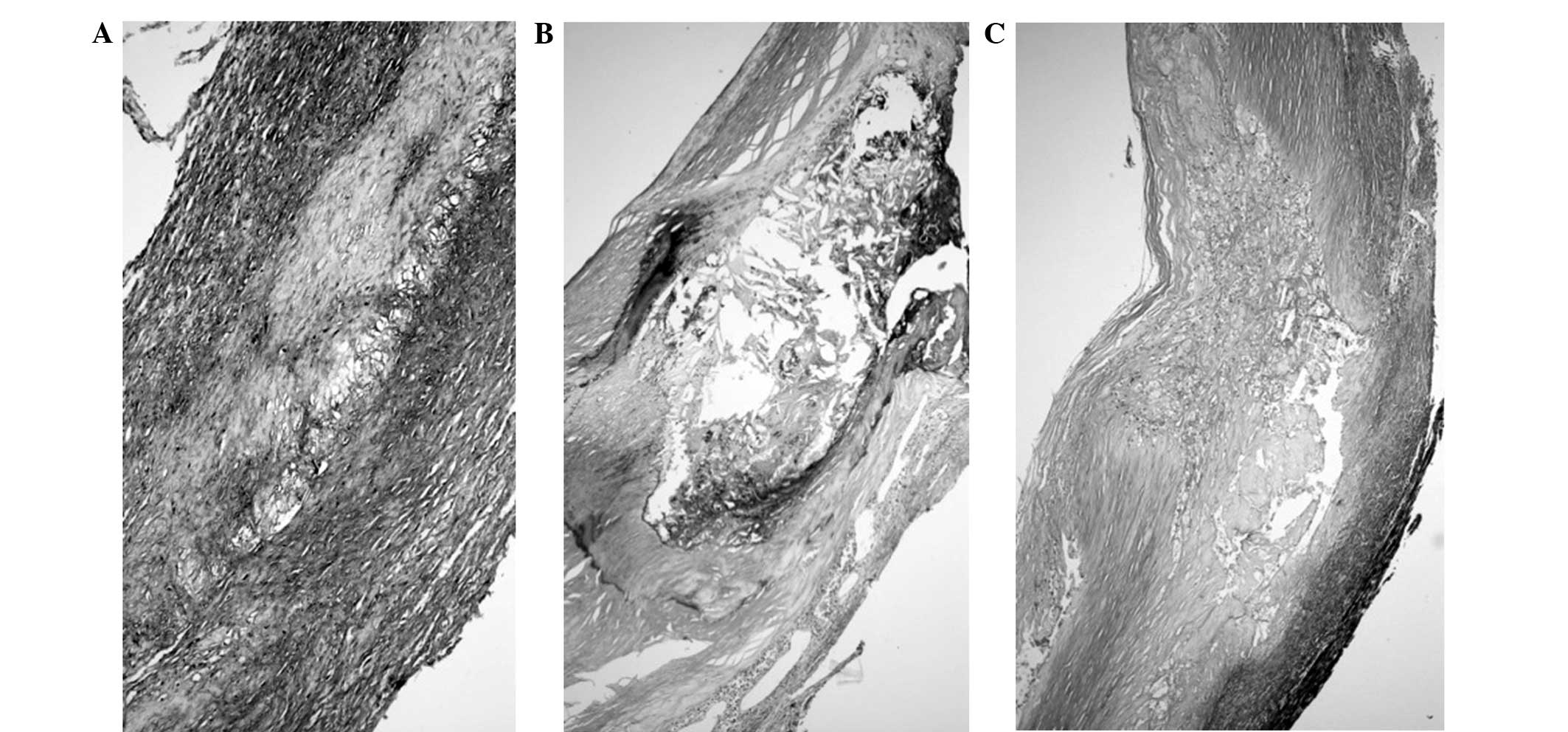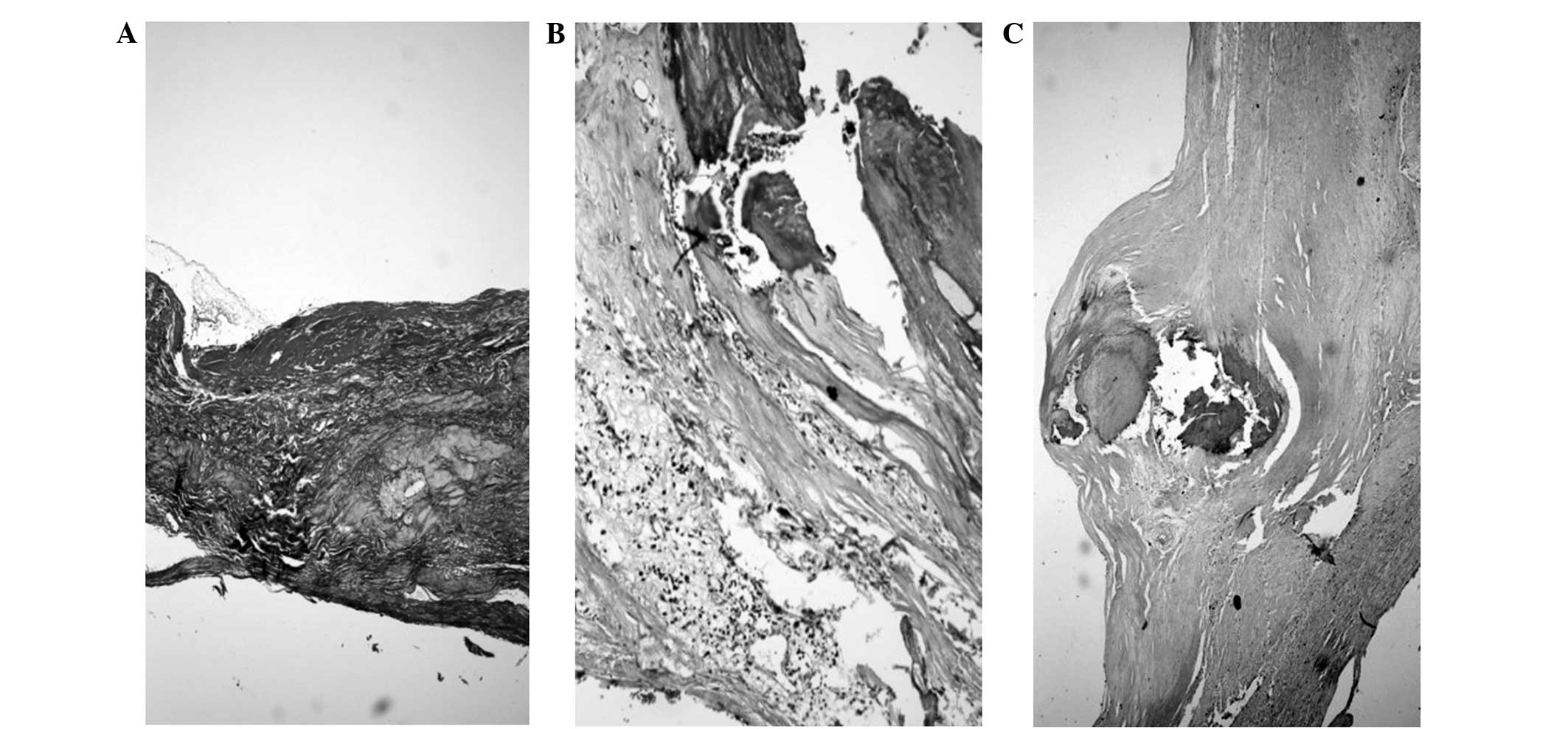|
1
|
Falk E, Shah PK and Fuster V: Coronary
plaque disruption. Circulation. 92:657–671. 1995. View Article : Google Scholar : PubMed/NCBI
|
|
2
|
Moreno PR: Vulnerable plaque: Definition,
diagnosis and treatment. Cardiol Clin. 28:1–30. 2010. View Article : Google Scholar : PubMed/NCBI
|
|
3
|
Versteylen MO: Additive value of
semi-automated quantification of coronary artery disease using
cardiac computed tomographic angiography to predict for future
acute coronary syndrome. J Am Coll Cardiol. 61:2296–2305. 2013.
View Article : Google Scholar : PubMed/NCBI
|
|
4
|
Furie KL, Kasner SE, Adams RJ, Albers GW,
Bush RL, Fagan SC, Halperin JL, Johnston SC, Katzan I, Kernan WN,
et al: American Heart Association Stroke Council, Council on
Cardiovascular Nursing, Council on Clinical Cardiology, and
Interdisciplinary Council on Quality of Care and Outcomes Research:
Guidelines for the prevention of stroke in patients with stroke or
transient ischemic attack: A guideline for healthcare professionals
from the american heart association/american stroke association.
Stroke. 42:227–276. 2011. View Article : Google Scholar : PubMed/NCBI
|
|
5
|
Virmani R, Kolodgie FD, Burke AP, Farb A
and Schwartz SM: Comprehensive Morphological Classification of
Atherosclerotic Lesions. Arterioscler Thromb Vasc Biol.
20:1262–1275. 2000. View Article : Google Scholar : PubMed/NCBI
|
|
6
|
Fishbein MC: The vulnerable and unstable
atherosclerotic plaque. Cardiovasc Pathol. 19:6–11. 2010.
View Article : Google Scholar : PubMed/NCBI
|
|
7
|
Hirayama A, Saito S, Ueda Y, Takayama T,
Honye J, Komatsu S, Yamaguchi O, Li Y, Yajima J, Nanto S, et al:
Qualitative and quantitative changes in coronary plaque associated
with atorvastatin therapy. Circ J. 73:718–725. 2009. View Article : Google Scholar : PubMed/NCBI
|
|
8
|
Brajovic MD, Marković N, Loncar G,
Sekularac N, Kordić D, Despotović N, Erceg P, Donfrid B, Stefanović
Z, Bajcetić M, et al: The influence of various morphologic and
hemodynamic carotid plaque characteristics on neurological events
onset and deaths. ScientificWorldJournal. 9:509–521. 2009.
View Article : Google Scholar : PubMed/NCBI
|
|
9
|
Kim SH, Hong MK, Park DW, Lee SW, Kim YH,
Lee CW, Kim JJ, Park SW and Park SJ: Impact of plaque
characteristics analyzed by intravascular ultrasound on long-term
clinical outcomes. Am J Cardiol. 103:1221–1226. 2009. View Article : Google Scholar : PubMed/NCBI
|
|
10
|
Bayturan O, Tuzcu EM, Nicholls SJ, Balog
C, Lavoie A, Uno K, Crowe TD, Magyar WA, Wolski K and Kapadia S:
Attenuated plaque at nonculprit lesions in patients enrolled in
intravascular ultrasound atherosclerosis progression trials. JACC
Cardiovasc Interv. 2:672–678. 2009. View Article : Google Scholar : PubMed/NCBI
|
|
11
|
Hashimoto H, Tagaya M, Niki H and Etani H:
Computer-assisted analysis of heterogeneity on B-mode imaging
predicts instability of asymptomatic carotid plaque. Cerebrovasc
Dis. 28:357–364. 2009. View Article : Google Scholar : PubMed/NCBI
|
|
12
|
Mortaz Hejri S, Mostafazadeh D and
Sahraian M: Carotid endarterectomy for carotid stenosis in patients
selected for coronary artery bypass graft surgery. Cochrane
Database Syst Rev. CD0060742009.PubMed/NCBI
|
|
13
|
Finn AV, Kramer MC, Vorpahl M, Kolodgie FD
and Virmani R: Pharmacotherapy of coronary atherosclerosis. Expert
Opin Pharmacother. 10:1587–1603. 2009. View Article : Google Scholar : PubMed/NCBI
|
|
14
|
WRITING GROUP MEMBERS. Lloyd-Jones D,
Adams RJ, Brown TM, Carnethon M, Dai S, De Simone G, Ferguson TB,
Ford E, Furie K, Gillespie C, et al: American Heart Association
Statistics Committee and Stroke Statistics Subcommittee: Heart
disease and stroke statistics-2010 update: A report from the
American Heart Association. Circulation. 121:e46–e215. 2010.
View Article : Google Scholar : PubMed/NCBI
|
|
15
|
Motoyama S, Sarai M, Harigaya H, Anno H,
Inoue K, Hara T, Naruse H, Ishii J, Hishida H and Wong ND: Computed
tomographic angiography characteristics of atherosclerotic plaques
subsequently resulting in acute coronary syndrome. J Am Coll
Cardiol. 54:49–57. 2009. View Article : Google Scholar : PubMed/NCBI
|
|
16
|
Van der Wal AC and Becker AE:
Atherosclerotic plaque rupture - pathologic basis of plaque
stability and instability. Cardiovasc Res. 41:334–344. 1999.
View Article : Google Scholar : PubMed/NCBI
|
|
17
|
Kolodgie FD, Virmani R, Burke AP, Farb A,
Weber DK, Kutys R, Finn AV and Gold HK: Pathologic assessment of
the vulnerable human coronary plaque. Heart. 90:1385–1391. 2004.
View Article : Google Scholar : PubMed/NCBI
|
















